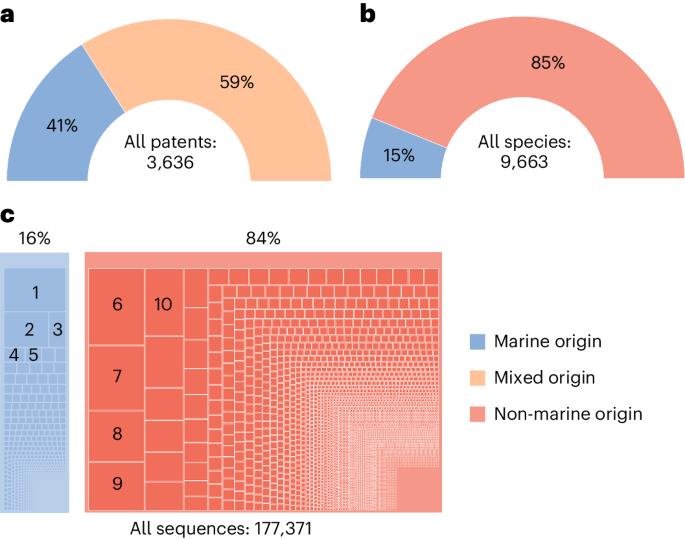深海生物在海洋生物勘探中的地位日益突出
IF 25.7
1区 环境科学与生态学
Q1 ENVIRONMENTAL SCIENCES
引用次数: 0
摘要
海洋生物勘探涉及从海洋生物中发掘遗传和生化材料,可用于解决广泛的公共和环境健康应用问题,如疾病治疗、诊断和生物修复。海洋遗传资源是此类生物勘探工作的重要资源库;然而,人们对海洋遗传资源在商业上用于天然产品发现的程度以及这些资源的海洋来源并不十分了解。在此,我们介绍一个专利申请中引用的海洋基因综合数据库--海洋生物勘探专利数据库。该数据库通过分析基因序列数据库中的所有相关记录,收录了与 4,779 项专利申请相关的 92,550 个蛋白质编码序列。仅三家公司--BASF、IFF 和 DuPont--就收录了 949 个物种的序列(超过一半的参考物种已确定来源于海洋)。深海中的微生物生命是一个广阔而遥远的生物群落,主要在国家管辖范围之外,已经吸引了大量的经济利益;排名前十的专利持有者都申请了引用深海生物序列的海洋基因专利。我们的研究结果让人们对海洋生物勘探有了最新的了解,有助于海洋生物多样性的可持续利用,并强调了政策制定者确保深海生态系统管理的必要性。海洋遗传资源是生物发现化合物的重要宝库,有助于应对公共和环境健康挑战。本研究介绍了海洋遗传资源商业利用数据库和分析,以实现海洋生物多样性的可持续利用。本文章由计算机程序翻译,如有差异,请以英文原文为准。

Growing prominence of deep-sea life in marine bioprospecting
Marine bioprospecting, which involves the exploration of genetic and biochemical material from marine organisms, can be used towards addressing a broad range of public and environmental health applications such as disease treatment, diagnostics and bioremediation. Marine genetic resources are important reservoirs for such bioprospecting efforts; however, the extent to which they are used commercially for natural product discovery and the marine sources from which they are derived are not well understood. Here we introduce a comprehensive database of marine genes referenced in patent filings, the Marine Bioprospecting Patent database. It includes 92,550 protein-coding sequences associated with 4,779 patent filings, identified by analysing all relevant records from genetic sequence databases. Three companies alone—BASF, IFF and DuPont—included sequences from 949 species (more than half of referenced species with identified marine origin). Microbial life in the deep sea, a vast and remote biome predominantly beyond national jurisdiction, is already attracting substantial economic interest; the top ten patent holders have all filed marine gene patents referencing sequences from deep-sea life. Our findings provide an updated understanding of the marine bioprospecting landscape, contribute to the sustainable use of marine biodiversity and underscore the need for policymakers to ensure stewardship of deep-sea ecosystems. Marine genetic resources are important reservoirs for biodiscovery compounds that can help address public and environmental health challenges. This study presents a database and analysis on the commercial use of marine genetic resources towards the sustainable use of marine biodiversity.
求助全文
通过发布文献求助,成功后即可免费获取论文全文。
去求助
来源期刊

Nature Sustainability
Energy-Renewable Energy, Sustainability and the Environment
CiteScore
41.90
自引率
1.10%
发文量
159
期刊介绍:
Nature Sustainability aims to facilitate cross-disciplinary dialogues and bring together research fields that contribute to understanding how we organize our lives in a finite world and the impacts of our actions.
Nature Sustainability will not only publish fundamental research but also significant investigations into policies and solutions for ensuring human well-being now and in the future.Its ultimate goal is to address the greatest challenges of our time.
 求助内容:
求助内容: 应助结果提醒方式:
应助结果提醒方式:


